Office Spaces Market Research, 2032
The Global Office Spaces Market was valued at $3.1 trillion in 2022, and is projected to reach $4.9 trillion by 2032, growing at a CAGR of 4.6% from 2023 to 2032.
Space office space is a specific location within a building or complex specifically designed and equipped for conducting business activity and accommodating employees. It provided a dedicated environment for work, collaboration and communication. Workstations, waiting areas, common areas, and facilities designed to encourage productivity and employee well-being are usually included in office spaces. It serves as a central hub where organizations carry out admirative tasks, conduct meetings, collaborate on projects and foster professional work culture. Offices spaces can vary in size layout and design to cater to the specific need of different industries and organization.
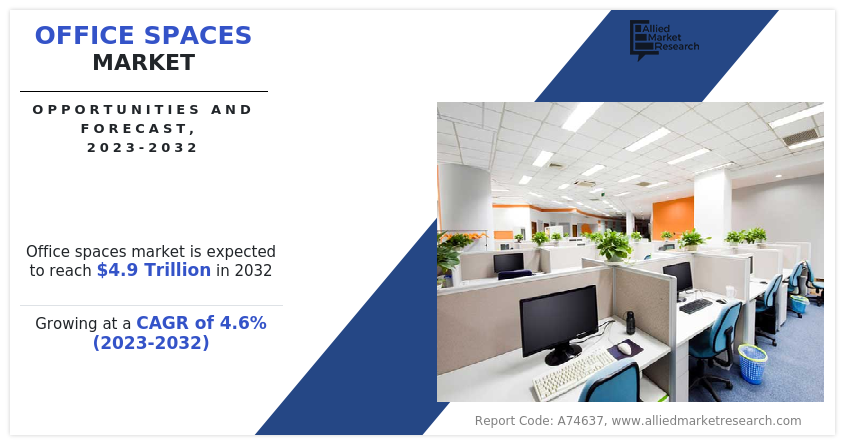
Market Dynamics
The market for office space market growth is driven by an increase in infrastructure projects for the commercial sector, such as the construction of new office buildings, business parks, or renovations of workplaces in urban areas. Additionally, this development brings in business, encourages the creation of jobs, and raises the need for office space in both developing and developed areas. Additionally, as more individuals move to urban regions in search of more opportunities and business expansion, the need for offices rises. Urban centers also frequently have better accessibility, a concentration of businesses, and a skilled workforce, which attracts businesses searching for a location.
In addition, growing businesses need more space to house their expanding workforces, and operational economic factors such as GDP (Gross domestic product) growth, employment rates, and business health have a significant impact on the need for office space. Additionally, businesses are reconsidering their requirements for office space due to the growth of remote work and flexible work arrangements. Furthermore, although certain companies are embracing entirely remote solutions, others are adopting hybrid modes that combine remote work with in-person collaboration. These factors may affect the need for conventional office space and fuel the demand for coworking, shared, or more adaptable workplaces.
However, several governments in emerging as well as advanced countries have been imposing rules and regulations for allocating certain regions for various types of land use, including commercial, residential, and industrial. The location of office buildings, building size and height, parking restrictions, and other aspects are also constrained by this regulation. Additionally, environmental regulations place limitations on some kinds of office space, particularly if they entail the use of hazardous materials. Environmental legislation also entails extra fees and standards for waste management, energy efficiency, and sustainable measurement. Furthermore, this law includes requirements for danger assessment, ergonomic ventilation system design, and emergency readiness. As a result, these environmental and building codes raise the cost of manufacturing and limit the market.
Moreover, the need for infrastructure investment is rising rapidly globally, but especially in developing economies. Between 2014 and 2025, it is anticipated that the investment in infrastructure construction will be around $78 trillion. In addition, investment in infrastructure has recovered from the global financial crisis and is anticipated to increase by more than $5 trillion by 2025. Furthermore, it is anticipated that the rapid urbanization of emerging markets like Indonesia, Nigeria, and China will increase spending on infrastructure, including on homes and offices. Additionally, growing use of sustainable construction has many benefits, including higher structural stability, quick and high-quality construction, superior flexibility, improved waste management, and a need for a lesser amount labor. All such instances are anticipated to provide lucrative opportunities for the growth of the office space market size.
Furthermore, several commodities, including food items, oil, and gas, saw a surge in price due to the Russia-Ukraine conflict. Due to supply chain interruptions, there are now more expensive shipping costs, fewer available containers, and less warehouse space. Since there have been delays in shipments and congestion, certain ports have been closed, and orders are being retracted, which influences industry and consumers globally. The decline in investor confidence has also increased stock market volatility. Economic instability has risen due to the strained commercial ties between Russia, Ukraine, and their different trading partners. Hence, all such factors have reduced export possibilities.
The office space market analysis is segmented into type, sale type, end user, and region. The types covered in the study include retrofits and new construction. Based on sale types, the market is divided into rent and sell. By end user, it is bifurcated into finance sector, retail and consumer goods, IT and telecommunication, co-working space, manufacturing industry, and others. By region, the office space market forecast is analyzed across North America (the U.S., Canada, and Mexico), Europe (Germany, the UK, France, Italy, and rest of Europe), Asia-Pacific (China, India, Japan, South Korea, and rest of Asia-Pacific), and LAMEA (Latin America, Middle East, and Africa).
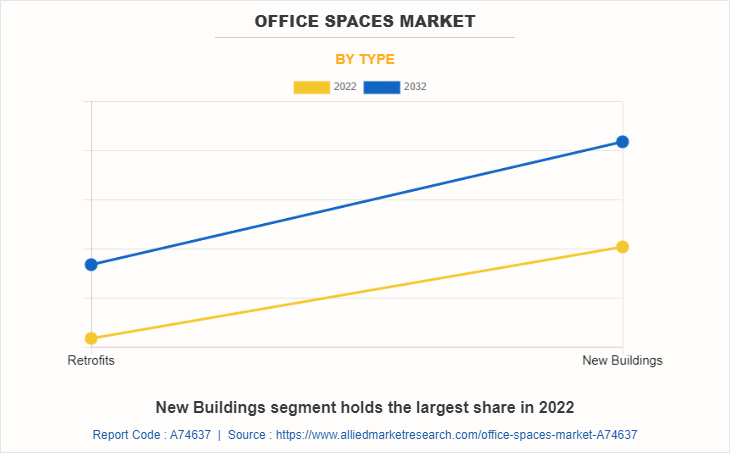
By Type:
The office space market is divided into retrofits and new construction. Retrofitting an office involves applying changes to an already operational space to enhance it. The goal is to boost production and enhance staff well-being while keeping standards and training in perspective. This comprises employing sustainable practices, updating systems such as lighting and HVAC, integrating technology, and optimizing space layout for flexibility. In addition, new construction office space is produced by completely reconstructing the current office building.
This procedure includes designing and building a facility especially tailored to the organization's demands and specifications while using the most cutting-edge architectural and technology aspects. The objective is to build workplaces with a specific atmosphere that reflects the company's mission, encourages efficiency, and supports the planned workflow. New Construction is expected to exhibit the largest revenue contributor during the forecast period. Retrofits is expected to exhibit the highest CAGR share in the applications of segment in the office space market opportunities during the forecast period.
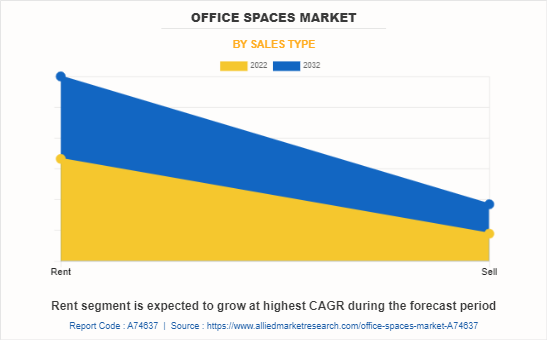
By Sales Type:
The office space market is divided into rent and sell. Renting office space refers to the process of releasing a specified section on a building or other piece of commercial property for the purpose of conducting business. For businesses to operate, collaborate, and serve clients or customers in a physical location without the long-term commitment and financial responsibility associated with owning a building, renting office space requires entering a contract for a predetermined amount of time with the landlord or property owner.
In addition, selling office space involves giving control or ownership of a certain area of a building or other commercial property to a different person in return for money. Finding a buyer willing to purchase the office space as well as negotiating the specifics of the sale are crucial procedures. The current owner was able to recoup their investment, transfer ownership, and even generate a profit by selling office space. The buyer assumed ownership of the office space and assumed responsibility for its upkeep, management, and use. The Rent segment is expected to be the largest revenue contributor during the forecast period and expected to exhibit the highest CAGR share in the product segment in the office space market during the forecast period.
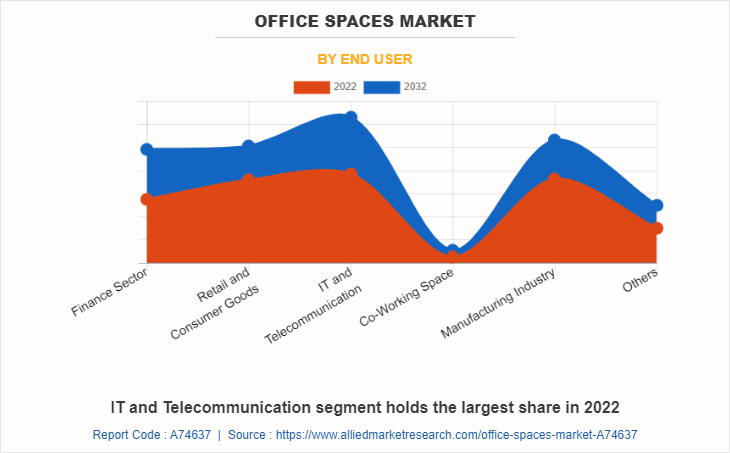
By End User :
The office space market is divided into finance sector, retail and consumer goods, IT and telecommunication, co-working space, manufacturing industry, and others. The term office space in the financial industry refers to actual, physical space, such as a building or commercial property, that is created and used by financial institutions and organizations to perform their business. The provision of financial services, including banking investments, asset management, insurance, and related activities, is centralized in this industry. In addition, Office space, as used by businesses in the retail and consumer products sectors, refers to specified areas inside a commercial structure that are used by these enterprises for operational, managerial, and administrative functions.
Furthermore, office space in the information technology and consumer goods industries refers to the specific section of the commercial property data that is used by businesses in the information technology and consumer goods sectors. Moreover, working space is a shared office setting where independent contractors and freelancers work together with small teams from various organizations in a community setting. It provides a collaborative workspace that is adaptable and enables individuals and organizations to work autonomously while yet being a member of a community.
Additionally, in the manufacturing sector, office space refers to a specific area within a manufacturing plant or complex that is especially intended to handle administrative and support operations. Office space is crucial to performing numerous administrative chores, even though the manufacturing industry's focus is the plant floor where things are made, and others end users include media and entertainment, retail and consumer goods, education and research centers, technology startup and innovation driven companies, freelancer and remote workers, and non-government organizations. IT and Telecommunication segments are expected to be the largest revenue contributor during the forecast period, and the co-working space segment is expected to exhibit the highest CAGR share in the propulsion system segment in the office space industry during the forecast period.
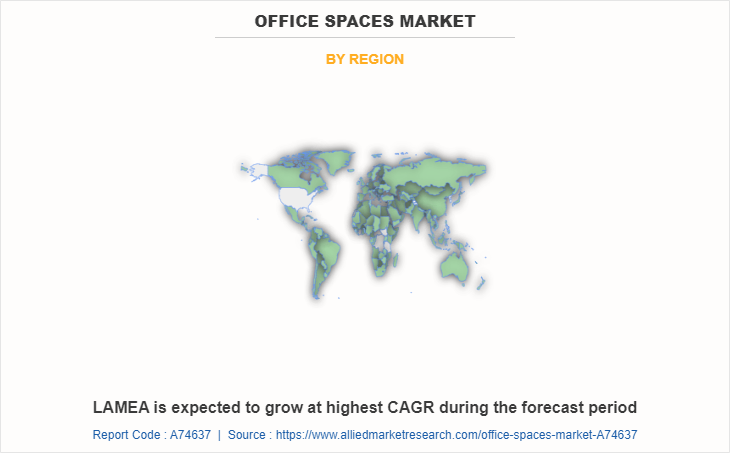
By Region:
The office space market trends is analysed across North America, Europe, Asia-Pacific, and LAMEA. In 2022, Asia-Pacific held the highest revenue in office space market share and expected to exhibit the highest CAGR during the forecast period.
Competition Analysis
The key companies profiled in the office space market report include Jones Lang LaSalle Incorporated, IWG plc, Savills plc, RMZ Corp, Skanska AB, Oberoi Realty Limited, SOHO China Limited, DLF Limited, Benhar Office Interiors and Aakash Group. Major companies in the market have adopted acquisition, product launch, business expansion, and other strategies as their key developmental strategies to offer better products and services to customers in the Office spaces market.
Key Benefits For Stakeholders
- This report provides a quantitative analysis of the market segments, current trends, estimations, and dynamics of the office spaces market analysis from 2022 to 2032 to identify the prevailing office spaces market opportunities.
- The market research is offered along with information related to key drivers, restraints, and opportunities.
- Porter's five forces analysis highlights the potency of buyers and suppliers to enable stakeholders make profit-oriented business decisions and strengthen their supplier-buyer network.
- In-depth analysis of the office spaces market growth segmentation assists to determine the prevailing market opportunities.
- Major countries in each region are mapped according to their revenue contribution to the global market.
- Market player positioning facilitates benchmarking and provides a clear understanding of the present position of the market players.
- The report includes the analysis of the regional as well as global office spaces market trends, key players, market segments, application areas, and market growth strategies.
Office Spaces Market Report Highlights
| Aspects | Details |
| Market Size By 2032 | USD 4.9 trillion |
| Growth Rate | CAGR of 4.6% |
| Forecast period | 2022 - 2032 |
| Report Pages | 220 |
| By Type |
|
| By Sales Type |
|
| By End User |
|
| By Region |
|
| Key Market Players | IWG plc, Jones Lang LaSalle Incorporated, RMZ Corp, DLF Limited, Skanska AB, Savills plc, SOHO China Limited, Benhar Office Interiors, Aakash Group, Oberoi Realty Limited |
Analyst Review
Strong economic growth stimulates business activity and creates demand for office space as companies expand and new businesses emerge. In addition, increasing urbanization and population growth drive the need for office space inside city centers and suburban areas where business activities are more. Furthermore, economic recession and financial crisis can lead to reduce the business activity downsizing and lower demand for office space likewise high rental cost maintenance expenses and property tax can be barrier for business seeking office space especially for startups and small businesses. However, the rise of flexible work arrangement present opportunity for provider of coworking space and share of the solution that carter to the need of freelancer startups and remote workers likewise the focus on sustainability and environmental responsibility create opportunity for developer and provider of ecofriendly offices space that meet green building certification and attract environmentally conscious tenant.
The global office spaces market was valued at $3,096.8 billion in 2022, and is projected to reach $4,919.7 billion by 2032, registering a CAGR of 4.6% from 2023 to 2032.
The forecast period considered for the global office space market is 2022 to 2031, wherein, 2022 is the base year, and 2032 is the forecast year.
The latest version of global office space market report can be obtained on demand from the website.
The base year considered in the global office space market report is 2022.
The major players profiled in the office space market include Jones Lang LaSalle Incorporated, IWG plc, Savills plc, RMZ Corp, Skanska AB, Oberoi Realty Limited, SOHO China Limited, DLF Limited, Benhar Office Interiors and Aakash Group
The top ten market players are selected based on two key attributes - competitive strength and market positioning.
Based type the new building segment was the largest revenue generator in 2022.
The report contains an exclusive company profile section, where leading companies in the market are profiled. These profiles typically cover company overview, geographical presence, market dominance (in terms of revenue and volume sales), various strategies and recent developments.
Loading Table Of Content...
Loading Research Methodology...



